Fig. 3.
Model robustness to partial data. a The correlation coefficient r2 was computed for the Fission yeast dataset using as training set different fractions of the data. b Using only the data for the first 250 generations of the Budding yeast dataset fitness was predicted for 500 generations. The coefficient of correlation r2 as computed between the predicted and the observed fitness at 500 generations for each model (Power Law r2 = 0.48, Stickbreaking r2 = 0.03, Saturation r2 = 0.18, Thermodynamics r2 = −0.02, and FGM r2 = 0.05). c Using the informations on the initial 10,000 generations the next 40,000 generations of the LTEE were predicted. The coefficient of correlation r2 as computed between the predicted and the observed fitness for the last 40,000 generations for each model (linear r2 = 0.82, Power Law r2 = 0.78, Stickbreaking r2 = −1.6, Saturation r2 = 0.48, Thermodynamics r2 = −1.7, and FGM r2 = −1.8)

